The New York Correspondence School is an alternative social network formed by the artist Ray Johnson who encouraged artists, friends, acquaintances, and strangers to share their art through the postal system. Johnson began sending aestheticized mail to his friends as a teenager in the 1940s, a practice he continued to develop while studying at Black Mountain College, and by the 1950s, these mailings, often called “mail art,” had become a major aspect of Johnson’s work as an artist. In 1962, Ed Plunkett, one of Johnson’s correspondents, named the international network of participants “The New York Correspondence School” (NYCS)[1], a play on “The New York School” of abstract expressionist painters. Johnson’s mailings to the NYCS turned forms of communication and education into artistic media in personal letters, mass-produced flyers, absurd packages, and everything in between. While a multiplicity of reoccurring images and references appear in Johnson’s work, from animals such as his trademark bunny head, to pop stars and pop artists, the educational themes are crucial to understanding the NYCS as a network critical of the larger commercialized art world. Johnson reeducated his correspondents with mailings such as his “brief histories” and “how to draw” instructions, which destabilized traditional definitions of art and education. By encouraging collaboration and participation, these pedagogical mailings undermined notions of individual authorship and created a new model for network-based art experiences. The curriculum of the NYCS existed in constant flux; Johnson’s lessons were open to the indeterminacies, chance encounters, and free-associations inherent to both aesthetic and interpersonal experiences.
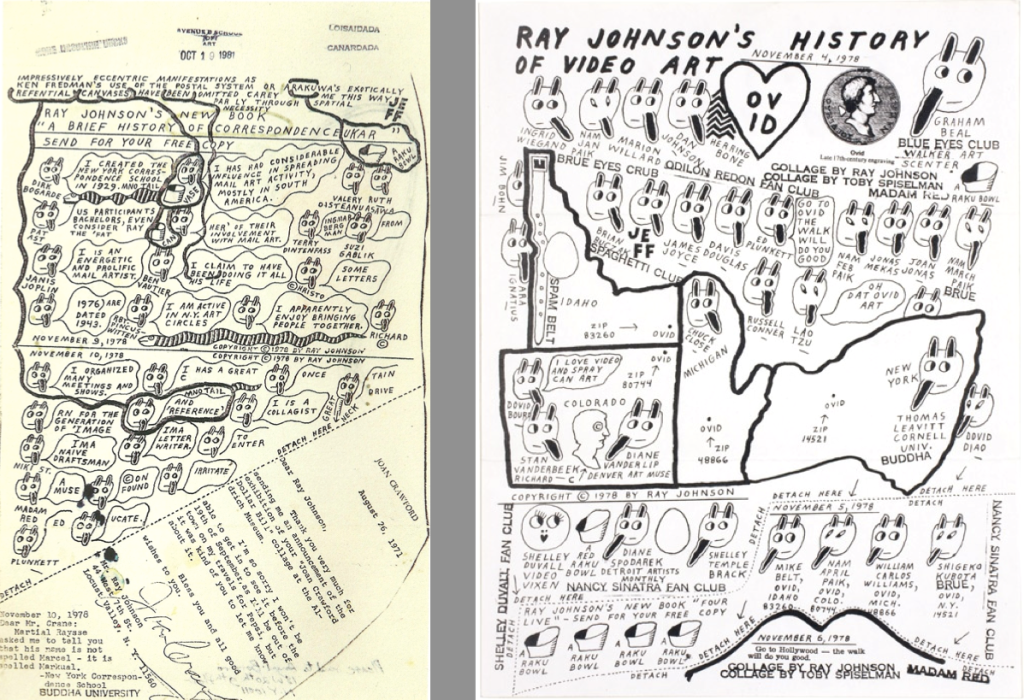
A clear history of the NYCS is impossible to establish since it involves the collective activities of a shifting group of people and because Johnson enhanced factual uncertainties by including unreliable statements and incorrect dates in his work. “The New York Correspondence School has no history—only a present,”[2] as Johnson often wrote. William S. Wilson, a scholar and friend of Ray Johnson, explained, “no one learns the whole story from Ray.”[3] Johnson’s nonlinear and indeterminate version of history is one of the subjects of his pedagogical mailings as seen in his History of Video Art (fig.2), and A Brief History of Correspondence (fig. 1). In the latter, named and unnamed bunny heads dictate a fragmented narrative of Johnson’s involvement with the NYCS as follows: “(I created the New York Correspondence School in 1929.) (I has had considerable influence in spreading mail art activity, mostly in South America) (I is an energetic and prolific mail artist) (I am active in N.Y. art circles) (I claim to have been doing it all his life)”and the story continues. Though written by Johnson, his attribution of these statements to many different speakers, and the fragmentation of the ambiguous chronicle, reveal the subjectivity and incompleteness inherent to history in general. In A History of Correspondence, the speech bubbles are both open and closed, like history in which events occurred in the past but are open to reinterpretation and have continuing effects in the present, as exemplified by Johnson’s combination of grammatical tenses. In A History of Video Art (fig. 2), rather than constructing a story, Johnson labeled some of the heads with names of video artists such as Joan Jonas, Nam June Paik, and Jonas Mekas, but he also included names of people who are not directly related to video art, like James Joyce and William Carlos Williams. Johnson’s histories reveal the porous and fragmented nature of history, which is filled with innumerable relationships, disjointed information, and incomplete narratives leading to multiple interpretations in constantly shifting contexts. In an interview with Henry Martin in 1982, Johnson remarked, “history is a very loose subject in which anybody can declare that anything happened at any time at all; and maybe that will be accurate information and maybe it won’t be, and maybe that won’t make any difference.”[4] Both history and the NYCS are indeterminate networks, the full scope of which cannot be comprehended or charted by a single person. Rather than aiming for an impossible goal of completeness or a linear progression, Johnson’s mailings illustrate that history has potential to be an open and creative field in which new connections can be discovered and constructed.
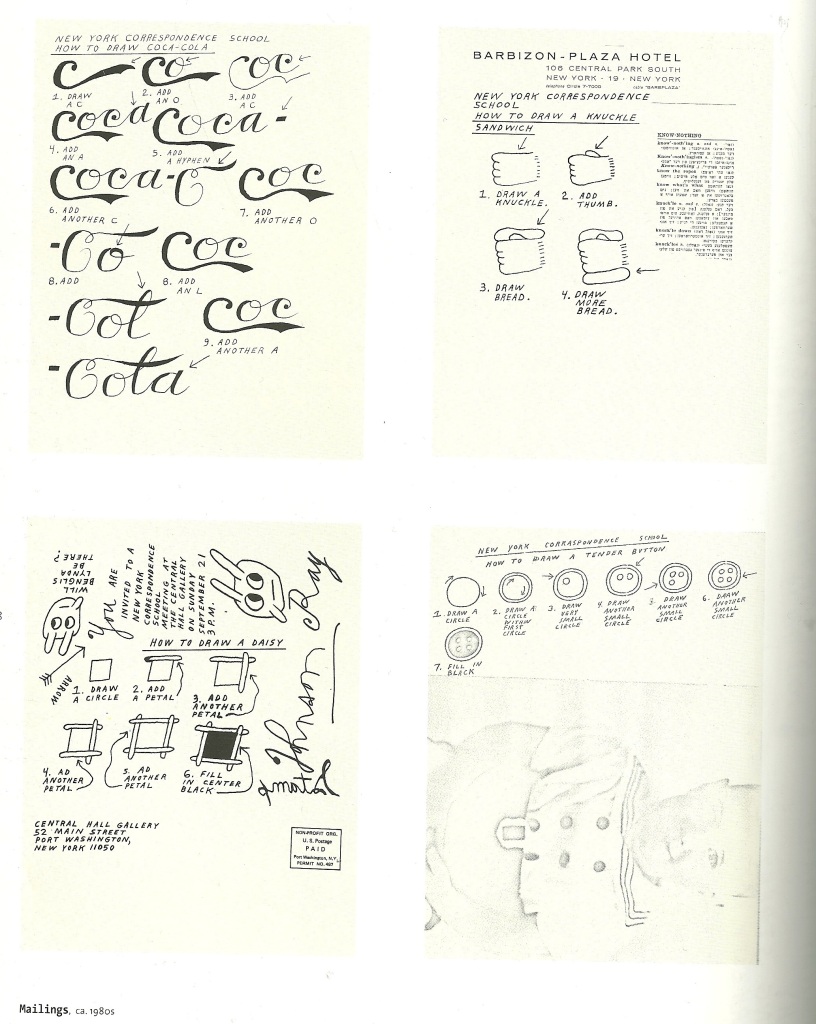
Just as he reeducated his correspondents about the composition of history with mass-produced mailings, Johnson distributed numerous “how to draw” instructions (fig. 3), which explore the relationship between language and images and reveal contradictions in the values perpetuated by the art market and commodity culture. By mimicking the methodical and generic aspects of beginner’s step-by-step art instructions, Johnson’s drawing lessons question the definition of art and paradoxically suggest that the process of making art both can and cannot be reduced to simple repeatable steps. Further complicating notions of being, definitions, and meaning, these drawings also explore relations between literal and figurative uses of language and images. “How to Draw a Daisy” is not an illustration of the flower, and “How to Draw a Knuckle Sandwich” renders the subject literally rather than the common figurative connotation of a punch to the mouth. “How to Draw a Tender Button” twists the figurative and literal in a pun on a literary subject, the title of Gertrude Stein’s 1914 collection of poems, Tender Buttons. In addition to playing with the relation between language and images, these ostensibly simple drawing instructions destabilize the opposition between the unique production of an original work of art and the reproduction of multiple copies by conflating seemingly opposed methods of production: they were both drawn by hand and mass-produced with a photocopier. Johnson’s drawing lessons illustrate their own production and reproduction. They were made for repeatability and produce difference in each instance of their reproduction since Johnson and other mail artists often reused the copies in collages and other new contexts. By drawing attention to systems of production and reproduction, Johnson rendered the original sources of these drawing lessons to be less significant than the abundance of new art that the copies potentially inspired.
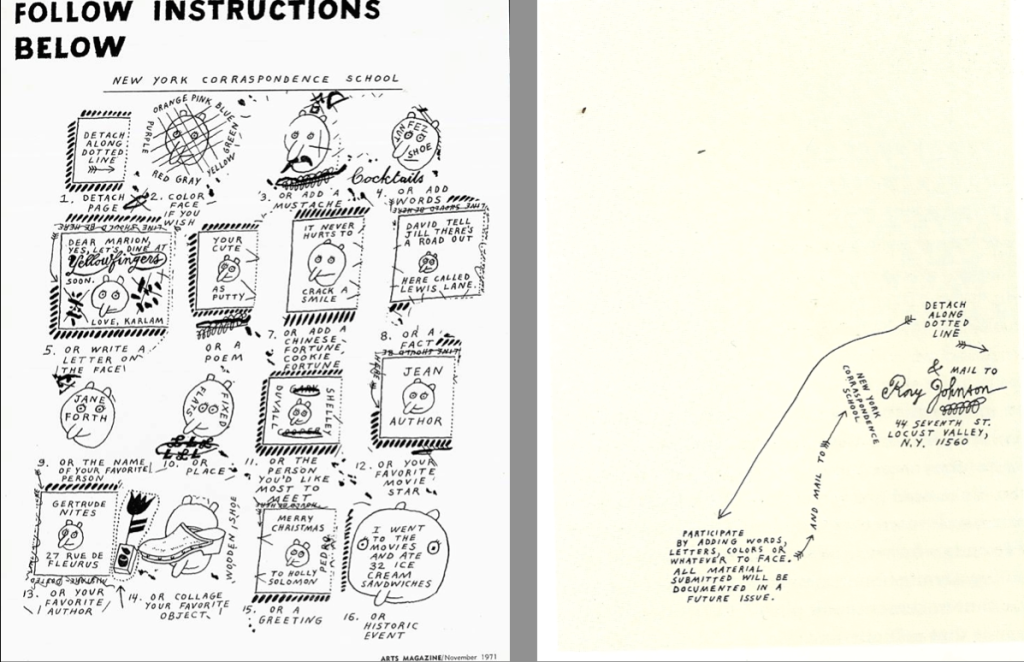
Figure 5 (right). Ray Johnson, Follow Instructions Below (page 2), 1971
Active participation and collaboration between correspondents were crucial to maintaining the interconnected network of the New York Correspondence School. In addition to his “how to draw” mailings, Johnson encouraged contributions from new correspondents by printing these images alongside a photograph of the French poet Arthur Rimbaud in Arts Magazine in 1971 (fig. 4, fig. 5). Johnson prompted readers to modify or add to the photograph of Rimbaud with humorous open-ended suggestions and illustrations such as, “(color face if you wish) (or add a mustache) (or write a letter on the face) (or add a Chinese fortune cookie fortune) (or a fact).” Unlike traditional school assignments, these suggestions were not mandatory. Participation, however, was an integral part of the NYCS, since the network would dissolve without correspondents continuing to circulate mail.
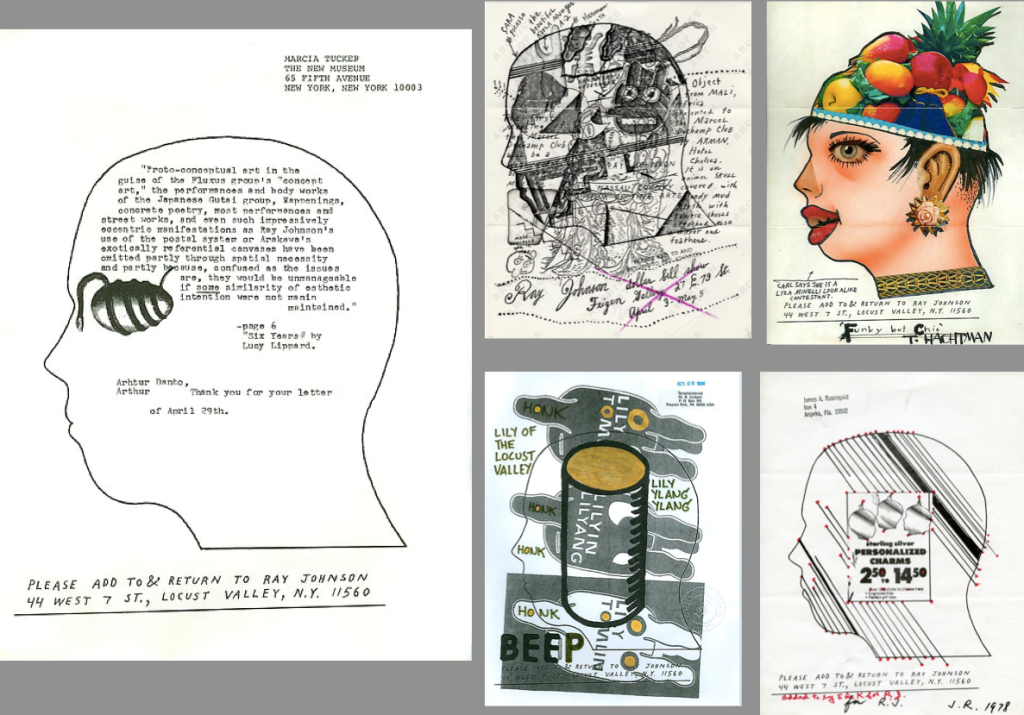
Johnson prompted responses with open-ended “Please Add and Return” mailings, which like his “how to draw” instructions, he mass-produced and distributed to his correspondents. Included on this slide (see fig. 6) are a few examples of other mail artists’ modifications and of Johnson’s own reuse of one of his templates, a silhouette of his head. These “Please Add and Return” mailings could be compared to fill in the blank worksheets or homework assignments, but rather than inducing conformity or having a correct answer, these templates use sameness to stimulate diversity.
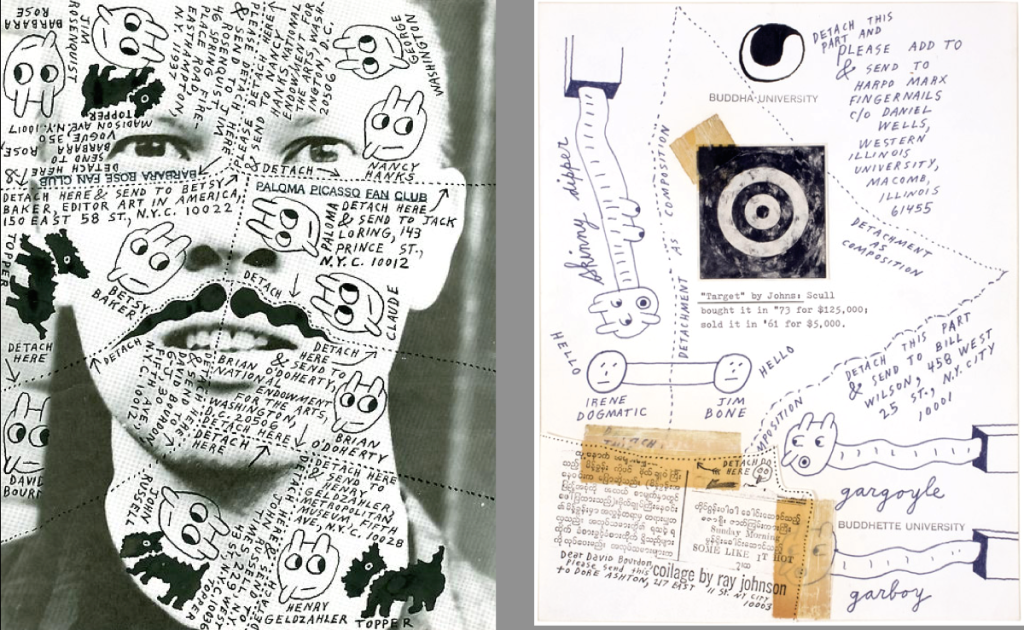
Figure 8 (right). Ray Johnson, Detachment as Composition
Another way in which Johnson encouraged participation was by suggesting that his correspondents disperse his work is by detaching parts and sending them to other people (fig.7, fig. 8). These instructions prompt his correspondents to relinquish the desire to preserve Johnson’s mailings and their own work. Through cutting up one work of mail art, the participant would construct new connections by sending the pieces to other people exemplifying the notion “detachment as composition” which Johnson wrote near the center of the image on the right (fig. 8). It is unknown to what extent his correspondents actually followed the instructions to cut up his mailings, since there are more intact than dismembered surviving examples. Nonetheless, the invitation to destroy his work in order to distribute it to a wider audience paired with the request that correspondents “add and return” some of their work are lessons that direct participants to accept the ephemerality of mail and art and to be more open to chance and change. As Johnson explained in a 1968 interview, “I never used to believe in a work of art being bought. I thought it should just be made and not cherished or sold.”[5] The contingency and immediacy inherent to both making art and interpersonal communication are the links connecting members of the NYCS.
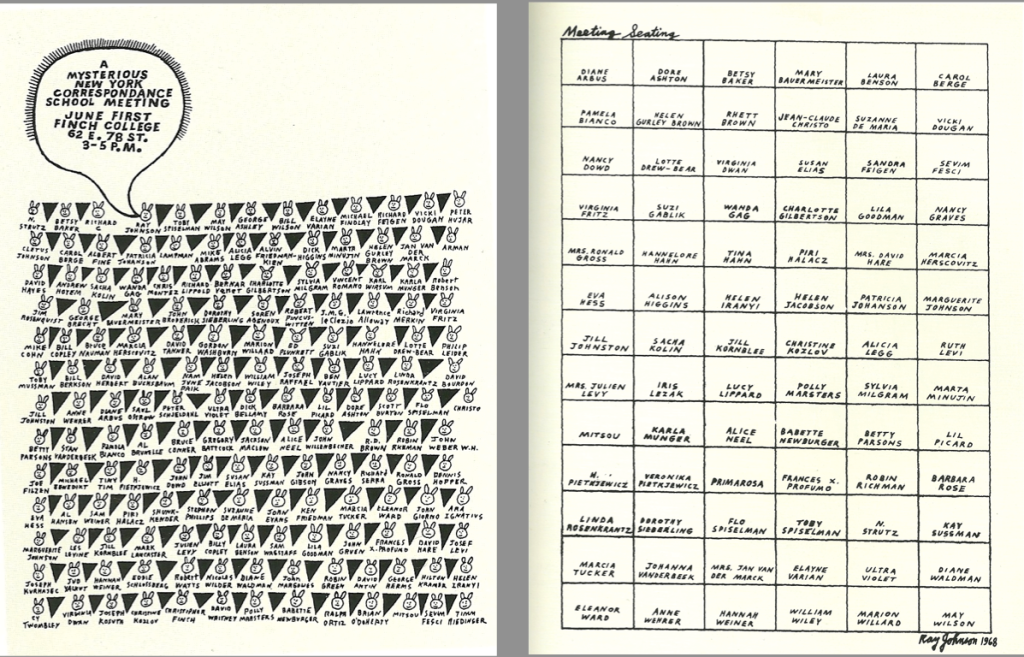
Figure 10 (right). Ray Johnson, Meeting Seating, 1968
In addition to circulating mail, Ray Johnson organized in person meetings for members of the New York Correspondence School. He often invited participants to these meetings with gridded lists and seating charts as seen in the invitation (fig. 9) and meeting seating from 1968 (fig. 10). Some of the New York Correspondence School meetings were for themed events such as the Stilt Walk or for one of Johnson’s numerous special interest fan clubs such as the Marcel Duchamp Fan Club, the Shelley Duval Fan Club, and the Paloma Picasso Fan Club, to name only a few. Remembering a meeting of the Paloma Picasso Fan Club, Johnson noted, “lots of glamorous people came…. They wanted to know why they were there. I told people I was trying to create a room with a certain number of people. But magically the right number of people did not come.”[6] The reoccurring structures of grids and lists in Johnson’s mailings create illusions of order, but the meetings were often absurd, unorganized, or haphazard events. Unlike traditional class meetings in which an instructor is prepared with a lesson plan and clear objectives, the NYCS meetings generally lacked such goal-oriented agendas and Johnson allowed events to unfold spontaneously. Describing his performances and meetings Johnson explained, “I begin with no plan. I face the void…I play…I do nothing.”[7] He showed that free play and chance could disrupt the rigidity of ordered systems, and that coherence and completeness should not be goals of endeavors related to education or art.
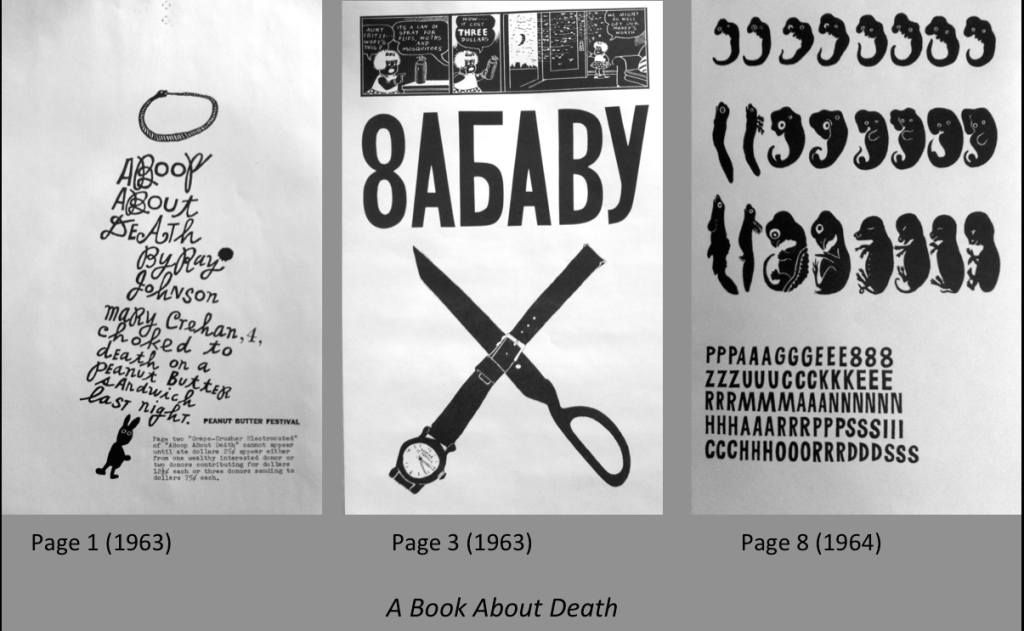
Figure 12 (middle). Ray Johnson, A Book About Death, page 3, 1963
Figure 13 (right). Ray Johnson, A Book About Death, page 8, 1964
Some of Johnson’s mailings took the form of books, a medium he used from the 1950s, when he made editions of small self-promotional pamphlets, to the 1990s, during which he made several unique books, some of which he sent to Clive Phillpot, the librarian at the Museum of Modern Art, in order to bypass the museum’s accessions process but still be included in the collection. One of Johnson’s most significant books, A Book about Death, consists of 13 unbound pages (fig. 11, 12, 13), which he printed and mailed out at random between 1963 and 1965. No one was supposed to receive a complete edition so the book would remain open, unstructured, and incomplete. While two of the pages include text related to the tragic death of a child, the larger collection of images and themes, from postage stamps, snakes, and cigar bands, to scissors, binoculars, and mickey mouse, do not cohere into a clear or single statement about death. The images prompt reexamination and contemplation about the various indirect and abstract possible ways in which the themes can be read in relation to death. Each new interpretation is just as probable and improbable as another. The incompleteness of every reading is built into the physically unbound structure of the book. William S. Wilson, one of Johnson’s closest friends, wrote, “For Ray, The Book about Death must remain an open work, lest an event of dying close a book on life. A closed book is death, or is an image of death, while The Book about Death is an open book. One theme of this unfinished Boom[k] about Death is that death does not close, death opens.”[8] Johnson took his own life in 1995 at age 67, and the prevalence of references to death in his work suggests that he frequently contemplated connections between his art, life, and death. Perhaps the network of mail artists with whom he corresponded acted as a support providing Johnson with a constant flow of new art bound with new ways of understanding life.
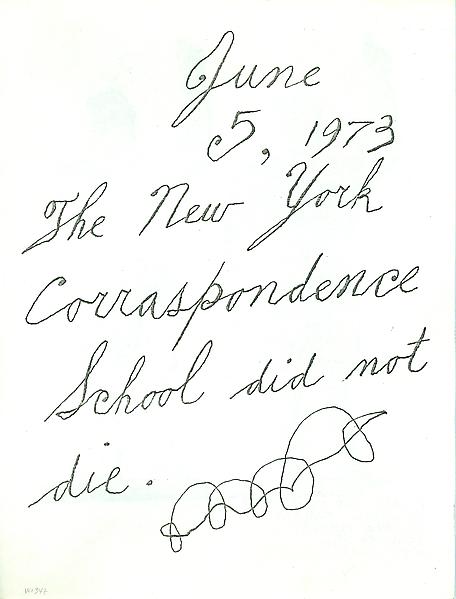
The New York Correspondence School lives on (fig. 14), as old and new mail artists continue to use the postal system, and now email, message boards, blogs, and the array of social media available on the internet, as both accessible methods of circulation and as an alternative to institutional exhibition spaces. Johnson’s mailings prompted participation and collaboration to form a community in which people share open-ended art that advances a different kind of being together, being together through being apart, whether in different neighborhoods or different countries. The random associations and enigmatic references in his messages are often difficult to decode, which renders his work indeterminate and open to numerous readings and re-readings. His pedagogical mailings destabilize conventional notions of art, art history, and socialization to cultivate more open modes of thought and free flowing experience. Adapting the format of a multiple-choice quiz (fig. 15), Johnson simultaneously questioned and answered, “mail art is not a square, a rectangle, or a photo, or a book, or a slide. It is a river.”
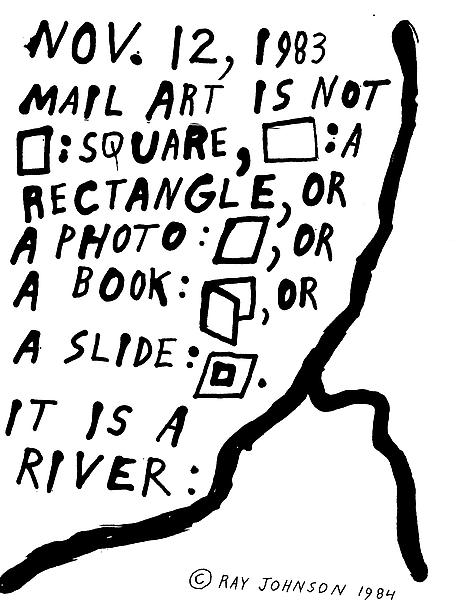
Sofia Kofodimos
2015
all images (c)The Ray Johnson Estate
recording of the presentation : https://www.youtube.com/watch?v=dzEmEiRKog4
[1] New York Correspondence School is abbreviated NYCS throughout, and sometimes spelled alternatively as New York Correspondance School, how Johnson often spelled it.
[2] Ray Johnson letter to David Bourdon December 25, 1975 found in Donna M., De Salvo, and Catherine Gudis, eds., Ray Johnson: Correspondences (Columbus, Ohio: Wexner Center for the Arts, 1999), 81.
[3] William S. Wilson, interview with author, March 14, 2013.
[4] Henry Martin, “Should an Eyelash Last Forever? An Interview with Ray Johnson,” in Ray Johnson: Correspondences, eds. Donna De Salvo, and Catherine Gudis, (Columbus, Ohio: Wexner Center for the Arts, 1999), 190.
[5] Gosse, “From Art to Experience: The Porous Philosophy of Ray Johnson”
[6] Lucy R. Lippard, “Special Deliverance,” in Ray Johnson: Correspondences, eds. Donna De Salvo, and Catherine Gudis, (Columbus, Ohio: Wexner Center for the Arts, 1999), 145.
[7] Ibid, 148.
[8] William S. Wilson, A Book About a Book about Death, 55.
Glad to have finally made my way to this blog! Excellent overview of Correspondance and I will return soon.
LikeLike